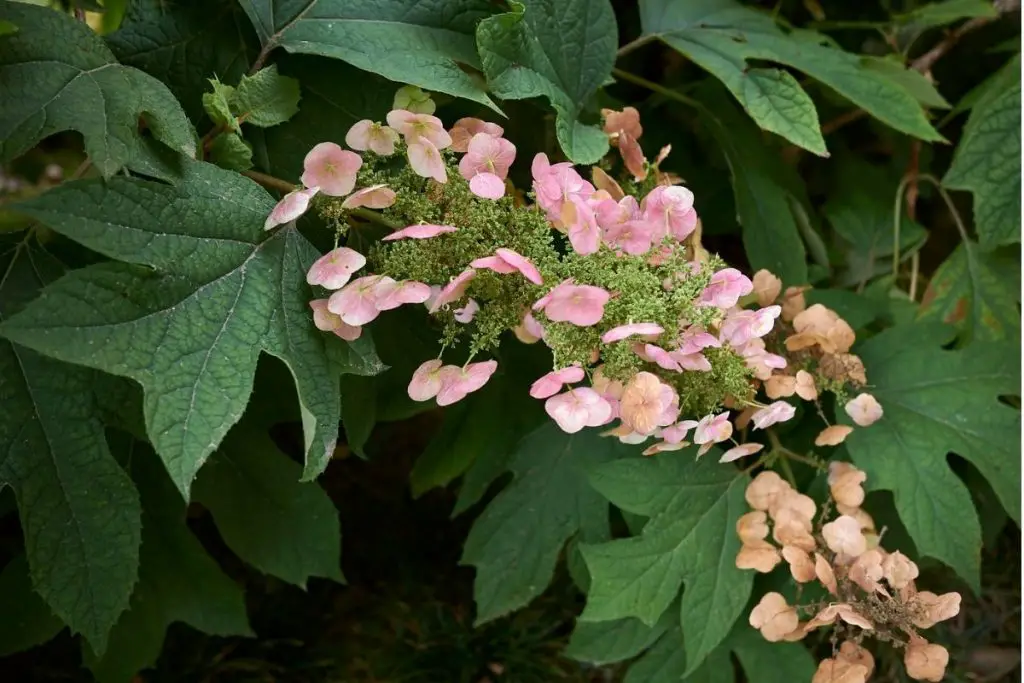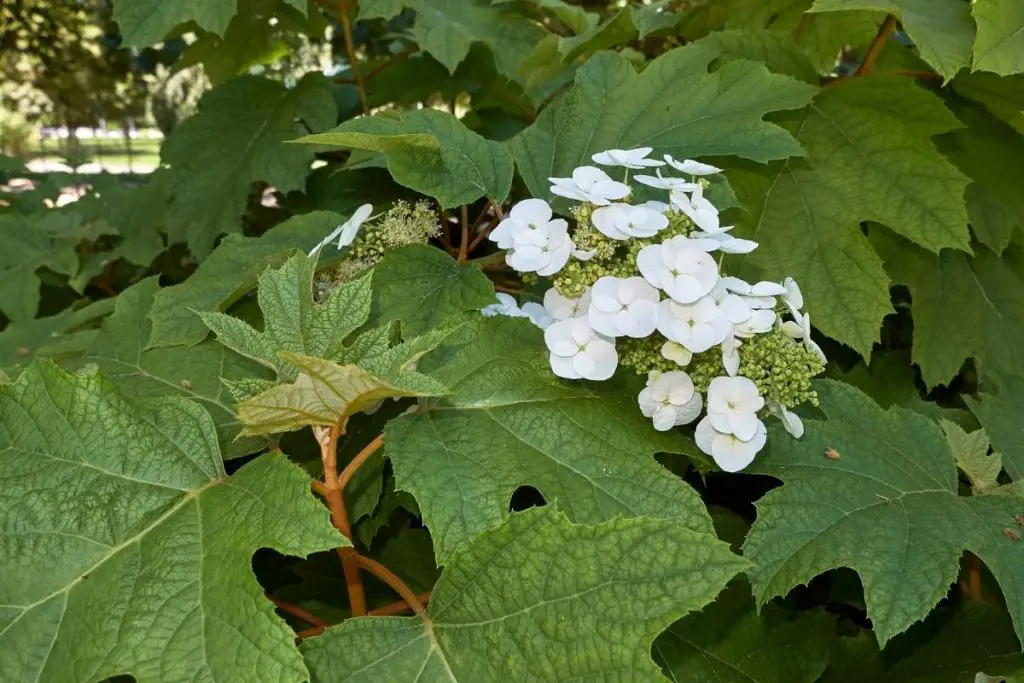H. quercifolia is not demanding to grow and is adaptable to soil conditions.
The oakleaf hydrangea shrub is, like almost all hydrangeas, a deciduous plant. It gets its name from the shape of its leaves, which are similar to those of an oak tree.
The Oakleaf hydrangea bush has the advantage of providing a long season of interest due to its color-changing leaves and flowers. The leaves turn a deep bronze color in fall. The oakleaf hydrangea flowers change from pure white to a pink shade as they age over the season. And even the bark is interesting in winter since the top layer of bark will flake off and inner layers will be revealed.
H. quercifolia is a plant that is native to the southeast of America. It is cold-hardy, tough, and drought-resistant.
The flowers, buds, and leaves of all hydrangea plants are mildly toxic as they contain an ingredient that breaks down to produce cyanide, which is extremely poisonous. However, large quantities of hydrangea flowers or leaves need to be ingested to invoke hydrangea poisoning.
History
The name Hydrangea quercifolia is derived from the Greek words: hydro (water) and angos (vessel) and from the Latin name for oak, which is quercus.
This hydrangea bush variety wasn’t well known until the late 18th century, when it was discovered by an American naturalist who imported many plants to Europe, including the H. quercifolia.
Plant Facts
| Scientific name | Hydrangea quercifolia |
| Common names | Oakleaf hydrangea, Oak-leaved hydrangea |
| Genus | Hydrangea |
| Family | Hydrangeaceae |
| Height | 1½ m to 2 ½ m (5 to 8 feet tall) |
| Width | 1½ m to 2 ½ m (5 to 8 feet) |
| USDA Plant Hardiness Zone | Zones 5 to 9 |
| Native to | Southeastern America |
| Blooming season | Summer to fall |
| Flower colors | White, becoming pink in fall |
| Plant specific features | Shrub with an abundance of cone-shaped flower clusters, color-changing leaves, and attractive bark in winter |

Growing Oakleaf Hydrangeas
There are three things to consider when planting oakleaf hydrangea shrubs – choosing the best site, preparing the soil for planting, and putting the plants into the ground.
This bush is available as a cultivar of different sizes, making it suitable even for smaller spaces.
Where to Plant
Oak-leaved hydrangeas will thrive in both sun and shade. A position where they will get morning sunlight is ideal. You can plant the shrub successfully in a woodland border, and it is a perfect plant to grow if you want to create a natural look in your garden.
When to Plant
Generally, oakleaf hydrangeas are purchased as pot-raised plants and can therefore be planted throughout the year. However, it is never a good idea to plant a hydrangea shrub if weather conditions are likely to stress the new plant, so avoid planting during the height of both summer and winter.
How to Plant
It’s very easy to plant an oakleaf hydrangea bush. You just need to dig holes that are 2 feet (0.61 m) larger than the roots in the pot or the root ball if the plant is bare-rooted.
The hole needs to be larger than the roots to give the roots a bit of help when they first start to grow. Backfill the hole around the roots of the plant with soft soil or compost.
The depth of the hole should be approximately the same as the root ball, so the plant is just a little higher than the soil. This will aid the drainage from around the plant.

Care and Maintenance
Here are some important oakleaf hydrangea care tips:
Soil
The basis for good growing conditions lies in the growing medium in which your plant is going to grow. Like all hydrangea bushes, H. quercifolia likes well-drained soil, enriched with plenty of organic matter.
Water
The newly planted hydrangea shrub should be kept well-watered until it has established a strong root system and can absorb water and nutrients from the soil. Once established, H. quercifolia is a drought-resistant plant.
Fertilizer
It is not usually necessary to apply fertilizer to oak leaf hydrangea plants, and if you choose to do so, make sure that the fertilizer is designed for the oakleaf. Different species of hydrangea plants require different fertilizer compositions.
If your bush does not flower well, then you might consider an application of fertilizer to promote flowering in subsequent years.
Sunlight
H. quercifolia is going to thrive whether you plant in shade or sun. But an ideal position to obtain better flowers in late summer is where it will get some morning sunshine.
Pruning
H. quercifolia is a hydrangea species that will only flower on old wood. These are the stems that produce the flaking woody bark in winter. Pruning should take place immediately after flowering has finished before new buds have formed. If you delay pruning, you will not have any flowers the following year, as you will have removed the developing flower buds.
To prune, cut off the faded blooms from the oak leaf hydrangeas. Remove any dead branches, then cut back and thin out the shrub.
Pests and diseases
No hydrangea shrub suffers unduly from pests and disease apart from occasional problems caused by leaf spot, aphids, and/or spider mite. Modern oakleaf hydrangea cultivars have integral resistance.
However, H. quercifolia is a plant that is extremely attractive to deer. Deer can do enormous damage in a garden, so if you grow this shrub, you should consider and possibly revisit your fencing!
Flowering Problems
If your oak-leaved hydrangea fails to flower well, it may be that you didn’t prune the hydrangea bush at the correct time, immediately after flowering had finished. Delayed pruning results in a lack of flowers the following year because the new buds wouldn’t have had sufficient time to develop on the old wood before the start of the plant’s dormant season.
Alternatively, it may be that your hydrangea plant isn’t getting enough sunlight. In this case, you will have super foliage but few flowers. This is most likely to be a problem if you are planting in a woodland setting, with an overhanging tree canopy.
Temperature and Humidity
Oak-leaved hydrangea shrubs are cold hardy to USDA zone 5. The best results are obtained in regions that receive some warmth in summer.
Propagating
The beauty and abundance of the oak-leaved hydrangea flowers will make you want to propagate your plant, and the good news is that it is easy to do so. Because some branches will be low-lying, a simple way to increase your plants is by layering. You need to peg the branches into the ground and cut them off once little roots have formed.
Alternatively, you can take cuttings from the stem in spring and pot them up once they have developed simple roots.
Other Uses for Oakleaf Hydrangeas
Given its year-round interest, toughness, and easy care requirements, it is no surprise that this is a plant that is frequently used by landscapers in diverse settings. You will find it as a hedging plant, a specimen plant, or planted in a border amongst other shrubs.
H. quercifolia is a good choice of hydrangea bush if you want to create a recreational garden or a garden for a children’s play area because it attracts butterflies and other pollinators.
Common Oakleaf Hydrangea Cultivars
Here are some popular types of H. quercifolia gardeners grow:
- ‘Snowflake’
- ‘Snow Queen’
- ‘Alice’
- ‘Harmony’
- ‘Sikes Dwarf’
- ‘Munchkin’
Conclusion
The oak-leaved hydrangea is a shrub that will give you pleasure throughout the year. With its non-demanding nature, it is a bush that should be on your shopping and growing list. You won’t be disappointed!
Check our website to learn more about hydrangea care and hydrangea types.
~ image source: depositphotos/simonapavan

